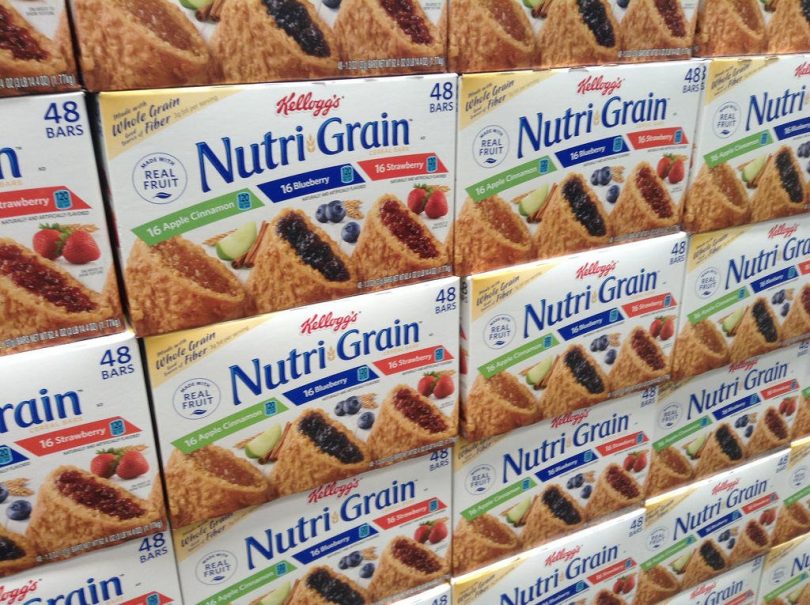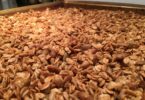Editor’s note: This is the second in a two-part series examining the phenomenon of class action lawsuits targeting the food and beverage industry. In part one, Food Dive explored why so many of these cases are filed.
In 2016, Kellogg was sued in a California court by consumers objecting to the company’s liberal use of health claims.
According to the initial complaint, labeling on about 50 packages included the phrase “whole grain” more than 130 times, “health” or “healthy” more than 40 times, “wholesome” more than 20 times, and “nutrition” or “nutritious” at least 15 times. Yet many of those products have high amounts of sugar, and the consumers argued it was misleading to allow Kellogg to use label claims that made them seem healthier.
Kellogg countered that all of its label claims were accurate, and that it never represented that its products were low in sugar. (The company did not respond to a request for an interview for this story.)
After years of arguments and filings, Kellogg agreed to a $20 million settlement in 2019, and to change its labels.
Where did that money go?
According to court documents, 513,342 of the potential millions of consumers who bought an affected Kellogg cereal between Aug. 29, 2012, and May 1, 2020, submitted a claim for a piece of the settlement. Depending on the amount of cereal each person bought, they received somewhere between $2.35 and $31.23, with the average refund being $14.09. The initial plaintiff received $10,000, and the four other named plaintiffs received $5,000 each.
The plaintiffs’ attorneys received the largest payout: 30% of the settlement fund, or $3.9 million. They also received nearly $1.2 million in case costs.
Top Class Actions President and CEO Scott Hardy said that he often hears from consumers who participated in class actions who are surprised at the small size of payments. But consumers need to recall what they spent on the product in the first place, he said.
“Sometimes people go, ‘Why did I only get 50 cents?’ And maybe that’s what you were truly due,” Hardy said.
Optional Caption
The $20 million settlement for Kellogg was large, but by no means unique in its size and scope. Rick Shackelford, co-chair of law firm Greenberg Traurig’s Food, Beverage and Agribusiness Practice, said that food and beverage manufacturers rarely budget for settlements, and often have to absorb the costs out of their operating funds.
But even when a class action case doesn’t end in a settlement, it is often a big headache for the manufacturer, Shackelford said. The lawsuits can be time consuming and expensive, and may put a company or brand’s very reputation on the line. Winning a class action case is a moving target, he said, and it can take many forms.
“The best definition of a win is the one that best meets the client’s interests — not only resolving this matter, however and at whatever stage it might be resolved — but that also protects the brand in the marketplace, the perception of the brand, that doesn’t cause harm to the sales,” he said.
Filing and fighting
It’s easy to file a class action lawsuit, said Charles Sipos, a partner in Perkins Coie’s food litigation segment. In general, it takes an idea, an attorney, a plaintiff and a filing fee.
Sipos said that the low barrier to entry is part of the reason class action cases in the food and beverage space are so popular. Another reason is that food is ubiquitous, and there’s always a large potential group of consumers who could have been wronged by a company. And product labels — complete with ingredient and nutritional claims — tend to be in circulation for a period of years, so there is ample time to prepare a case asserting that they are inaccurate.
Some class action complaints against food companies are longer and more detailed than others. The 2016 case against Kellogg for health-targeted labeling on sugary cereal is 148 pages long and presents a history of different forms of sugar, details on the body’s physiological responses to excess consumption and charts showing obesity and disease rates that can be correlated to eating the sweetener.
The initial vanilla lawsuit from prolific class action attorney Spencer Sheehan that accuses A&W Root Beer of deceiving consumers with a claim of being made with aged vanilla isn’t nearly as full of research. Instead, the 19-page complaint summarizes the craft of the soda jerks who custom-blended fountain sodas — often with vanilla — a century ago.
“The best definition of a win is the one that best meets the client’s interests — not only resolving this matter, however and at whatever stage it might be resolved — but that also protects the brand in the marketplace, the perception of the brand, that doesn’t cause harm to the sales.”

Rick Shackelford
Co-chair of Food, Beverage and Agribusiness Practice, Greenberg Traurig
Anecdotally, Shackelford with Greenberg Traurig said that he’s seen more cases being filed — and many of them being less formal — during the pandemic, especially since courts were largely out of commission for this type of case for much of 2020. But regardless of how detailed or formal the initial complaint is, food manufacturers have to do the same job of defending themselves.
In general, Sipos said, it takes much more work for a manufacturer to mount a defense than it does for a plaintiff to put together the case — a phenomenon he called “asymmetrical discovery.” The research and documentation that a manufacturer can ask for is largely limited to the plaintiffs’ purchase and dietary habits, including proof that a consumer bought the product in question, information on their normal eating patterns, and evidence of altered behavior because of the issue central to the lawsuit. Meanwhile, manufacturers can be forced to dig up voluminous documents on product ingredients, manufacturing methods and R&D.
Class action cases rarely see trial, though there are no detailed statistics on what happens to them and when. Shackelford sees them as a freeway with a lot of off ramps.
Manufacturers’ motions to dismiss cases are one of the first exits on this highway, as companies look for faults in the initial arguments.
A 2019 case claiming Mondelēz’s Nabisco and Honey Maid graham crackers had misleading labeling was dismissed before much litigation action in July 2020 by U.S. Magistrate Judge Sanket Bulsara. Among the judge’s reasons to dismiss the case were improper jurisdiction — the case was filed in a New York federal court, but only two of 17 named plaintiffs bought the product in the state. None of the plaintiffs were regular purchasers of the graham crackers and said in the future, they would only buy them if they felt the labels were not misleading. This means, Bulsara wrote, these consumers aren’t particularly harmed by current labeling. And, the judge said, reasonable consumers don’t equate graham crackers with a product made with whole wheat graham flour, which plaintiffs said they incorrectly assumed was an ingredient.
If a case isn’t dismissed at the beginning, Sipos said, the next test is at the class certification phase: determining whether there is a problem identified in the case that truly impacts a group of consumers. It can take up to a year and a half to get to this point, he said. That time is generally filled with finding expert witnesses, doing research and building a case.
All class action cases, regardless of the subject matter, need to go through this process. Whether a case is “legitimate,” Shackelford said, is in the eye of the beholder, but some are “better grounded.”

Optional Caption
“From both sides’ perspective, there can be some exploitation and ambiguities,” he said.
In October, a judge decided not to certify the class in a case against Breyers ice cream maker Unilever about the brand’s Natural Vanilla ice cream, which does not use 100% vanilla extract. In her ruling, U.S. District Judge Yvonne Gonzalez Rogers wrote the plaintiff “has not shown that the alleged misrepresentations could be deceptive as a matter of law.” The consumers filing the case submitted as evidence results of a study in which people were asked their preference for a container of ice cream that was flavored entirely with natural vanilla or one that had other vanilla flavoring. Although the survey showed 88.6% said they preferred the completely naturally flavored option, Rogers pointed out that they were not asked about how the origin of the flavoring would impact purchase decisions.
Because of the recent trend in class action suits in which a single attorney or firm files several cases about a single issue, Shackelford said attorneys are able to refine the arguments they make. Plaintiffs tend to start out by filing many cases about disparate issues, trying to figure out what kinds of arguments are more likely to be seen as more valid by a judge. In time, Shackelford said, plaintiffs’ lawyers figure out a sort of “model complaint” to make on a single topic that tends to survive early case-ending motions.
Who wins?
It’s not always clear who wins a class action case. There is usually no final judgment issued since most cases are settled or end on motions, and neither side tends to admit they were wrong. And the end goals of consumers bringing cases and manufacturers are very different than they might appear from listening to arguments and reading case filings.
Class action attorney Sheehan said he doesn’t just define victory as a court ruling in favor of his client. He also doesn’t see it as just getting a cash settlement for his clients — though he was careful to say that he isn’t only filing these cases “to serve a public purpose.” Above all, Sheehan said he wants to make a difference and to bring awareness to issues, especially disclosures he says “may be insufficient, to ambiguous, to flat-out deceptive.”
“That’s probably the best way to measure it,” he said. “We’re not going to be able to change industry from lawsuits. That’s not something that’s possible, and that’s really not the job of the judiciary.”
If the class is not certified, the case generally ends in favor of the defendant, Perkins Coie’s Sipos said. If the class is certified, it usually heralds the end of the case in favor of the plaintiff. When a class is certified, its size — and the maximum amount of damages — can balloon, and manufacturers usually opt to keep their losses as low as possible and settle. However, there is one important thing to note about settling a case: It’s not an admission of liability or wrongdoing.
“We’re not going to be able to change industry from lawsuits. That’s not something that’s possible, and that’s really not the job of the judiciary.”

Spencer Sheehan
Class action attorney
Sipos said that any time the truth and accuracy of food product labeling is challenged, companies want to defend it. The decision to settle can be difficult.
“It’s not because it’s not an issue worth fighting for,” Sipos said. “It’s just the practical realities of the class certification decision make it a very high-risk proposition to try a case.”
Settlement amounts are agreed upon by both sides in the case, and include attorneys’ fees, funding for named plaintiffs and for consumers who can show they purchased the product. Sipos said there’s often funds left over, which either can go to a charitable interest connected to the central issue in the case, or the amount that people get for making settlement claims can increase. Sipos sees left-over funds as a sign that the issue at the heart of a class action case really didn’t impact that many consumers.

Optional Caption
“People don’t make claims because they went out and bought exactly what they thought they were buying, or are satisfied with their purchase and don’t subscribe to whatever theory of deception might have been put forward in the case,” Sipos said.
Greenberg Traurig’s Shackelford said manufacturers’ overriding concern is always their brand equity. Being embroiled in a long fight over issues like fiber content or whether ingredients truly are natural may not be the best publicity for a company.
Sometimes, quietly making label changes and settling cases is the most advisable way to move forward, Shackelford said. This type of move doesn’t acknowledge that the people who brought the suit have an especially worthy claim, but it does show that there is room for the manufacturer to improve, and it puts an end to legal wrangling.
In the case of A&W Root Beer and its “aged vanilla” label claim, the company has since removed it from its packaging. Regardless of whether Keurig Dr Pepper would say that the change was a result of the litigation, Sheehan said it can be counted as a partial victory for consumers. (Keurig Dr Pepper did not respond to requests to comment for this story.)
However, the case still continues, and Sheehan said he will continue to fight for his clients. The products carried this label for years, Sheehan said, and it’s not over because the label is no longer deceptive, as he describes it.
“Who is that fair to?” he asked. “It’s not fair to the millions of people who bought it over a decade or however long they were saying that. …We can show that and get the monetary relief for the class.”
“People don’t make claims because they went out and bought exactly what they thought they were buying, or are satisfied with their purchase and don’t subscribe to whatever theory of deception might have been put forward in the case.”

Charles Sipos
Partner in food litigation segment, Perkins Coie
Top Class Actions’ Hardy said there is a high bar for class action lawsuits to damage brand equity. Sheehan has recently started filing lawsuits with a similar strategy as the vanilla cases, zeroing in on products that claim a particular flavor or component, but it is not reflected in the ingredients list. One that has received quite a bit of attention from both consumer media and on Hardy’s site is against Kellogg, claiming that the company’s Strawberry Pop-Tarts are deceptive because they contain just as much apple and pear as the namesake ingredient. Kellogg has not yet responded to the case in court, and has not responded to Food Dive’s interview requests as of press time.
Hardy said consumers have engaged a lot with that story, largely because most people have likely bought Strawberry Pop-Tarts at some point. But from his perspective, the lawsuit has done nothing to diminish the Kellogg toaster pastries’ brand value.
“People love what they love,” Hardy said. “…Because even though now I know that the Strawberry Pop-Tart might have more apple and pear than I thought, my kids still love it. I’m gonna go out and buy it.”
On the docket: More class action lawsuits
Class action lawsuits have been trending upwards every year, and Perkins Coie’s Sipos and Greenberg Traurig’s Shackelford both said the number may continue to increase. The ease of filing and the endless potential claims make it an easy mark.
And though this kind of class action case can bog down a court’s docket and bring an unclear sort of relief, attorneys and case watchers agreed that very little may be done to stop the flow of cases. After all, despite how manufacturers and members of the public who aren’t directly involved may feel, the ability to file class action cases goes back to peoples’ rights.
“Creating a bar or barrier that’s gonna either lock the doors of access to justice or make them more difficult to open — I don’t think that’s likely something that our society is going to have much of an appetite for,” Shackelford said.
“…That’s not to say that the medicine might not be a little harsher,” he continued.” Once you’ve unlocked the doors and you’re dealing with the merits of the case, I think there are a lot of claims that are filed on the basis of, ‘Your product doesn’t deliver X,’ when there’s been no independent testing of that proposition done whatsoever.”
There are ways that laws and regulations can be tweaked to close the door on opportunities for lawsuits. For example, a California law took effect in 2019 that made it harder for consumers to file “slack fill” class action lawsuits — claims that a company deceived consumers by putting too much air inside a package.

Optional Caption
Christopher Doering/Food Dive
Federal regulations could also be changed. The “natural” label claim, which has no regulated definition, has spawned scores of class action lawsuits. In 2016, the FDA had put out a press release trying to explain natural and artificial flavors, which some thought could be a precursor to an official action to set a definition for the nebulous term. After this, Shackelford said, cases involving this claim were more or less put on hold, waiting for the federal government to weigh in. Nothing further has come out of FDA since then, and lawsuits have picked back up.
Shackelford said he doubts a regulated definition would stop all of the litigation over “natural” claims, but it could clear up a lot of what has been filed.
“That’s an example where they had an opportunity to look at it, try and level the playing field or set some ground rules for everybody,” Shackelford said. “And the agency decided that it was happy — or not sufficiently unhappy — with status quo. That it should let the marketplace sort it all out. Unfortunately, it turns on case-by-case, label-by-label, judge-by-judge sets of evaluations.”
“Even though now I know that the Strawberry Pop-Tart might have more apple and pear than I thought, my kids still love it. I’m gonna go out and buy it.”

Scott Hardy
President and CEO, Top Class Actions
But class action lawsuits are not all bad. Shackelford said as long as a company is acting ethically and doing the right thing, there are times to be thankful for the plaintiffs’ bar. After all, these lawsuits bring up potential legitimate consumer complaints, and could help drive changes in another company before similar litigation against it can be filed, Shackelford said.
Top Class Actions’ Hardy thinks of class action lawsuits as a wake-up call to manufacturers to give them a chance to better serve consumers. When companies are sued, they tend to miss out on the PR opportunity presented, he said.
“They should be saying, ‘Hey, there was this class action filed against us. We disagree on the merits of it, but we love our customers. So this is what we’re doing to help you,’ “ Hardy said.
Meanwhile, attorney Sheehan said that he will continue to file class action lawsuits as long as there are consumer issues that need to be addressed.
“If everybody woke up tomorrow and just decided to be honest, I probably wouldn’t be doing this,” Sheehan said.








